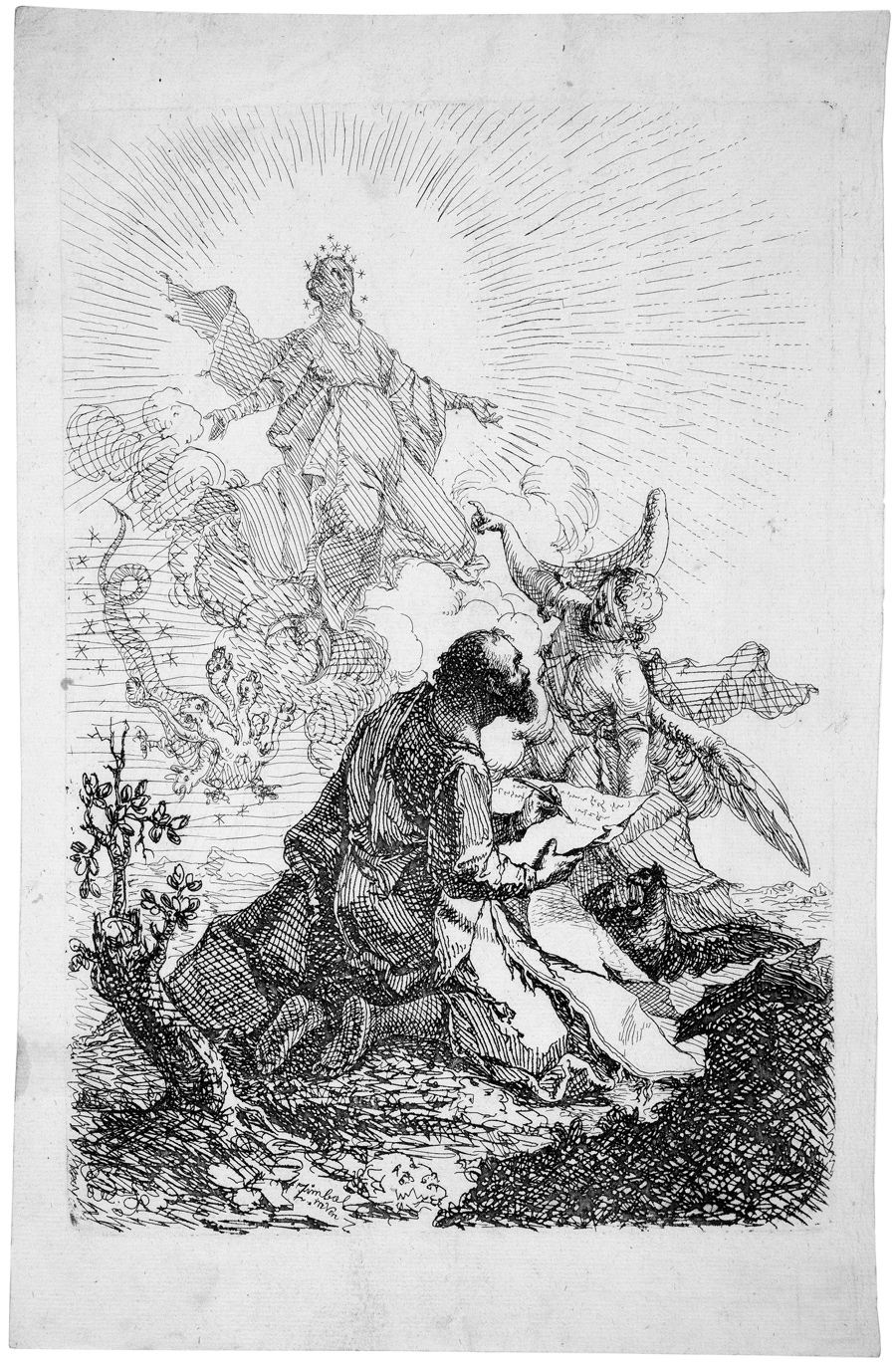Loading the page ...
Johann Ignaz Zimbal
(1722 Wagstadt – 1795 Vienna)
St. John the Evangelist Writing the Apocalypse on Patmos. Etching. 27.3 x 18.5 cm. Heller-Andresen 2; not in Nagler; Wilhelm Soldan, “Die Radierungen von Johann Ignatz Zimbal” in Galerie Bassenge, Berlin, Auction Catalogue 56, 1990, Part II, p. 51, 2; L. Slavícek, “Johann Cimbal as Etcher”, in Ex Fumo Lucem. Baroque Studies in Honour of Klára Garas, Budapest, 1999, pp. 112–113, 115, fig. 5.
The painter and etcher Johann Ignaz Zimbal belongs to a group of Austrian artists of the Late Baroque whose biographies have, thanks to intensive research, gradually assumed clearer contours in recent decades and whose work has consequently undergone reassessment. The best known artists of this period, such as Paul Troger, Franz Anton Maulbertsch and Michelangelo Unterberger, were among the first to be assigned their rightful place in the history of art, while other masters of their generation, including Zimbal, still await a comprehensive appreciation of their oeuvre.
Johann Ignaz Zimbal, the son of a carpenter, began his artistic training at the Vienna Academy in 1742 and studied there until 1745, when it was forced to cease its teaching activities for several years. In the subsequent period Zimbal continued his association with the Academy and, in the early 1750s, took part in several academic painting competitions it organized. It is symptomatic of many artists of his generation that far less is known about Zimbal’s drawn and printed oeuvre than about his painting. As Slavícek points out, in the Vienna of the 1750s the existence of an independent Drawing and Engraving Academy (Zeichnungs- und Kupferstichakademie), with which artists like Troger and Maulbertsch maintained close relations, created the necessary artistic climate in which academic painters could venture into the realm of printmaking. Artists such as Franz Karl Palko, Franz Sigrist and Zimbal found that etching was their preferred artistic medium, as it required less technical experience than engraving and permitted a freer, more painterly mode of expression. As the creations of non-professional printmakers, who were more interested in the expressive potential of the medium than in perfect craftsmanship, the works of these masters owe their appeal to their spontaneity and freshness. As a consequence the time lapse between the original artistic idea and its final realization is correspondingly short and the production of those artists is often very limited. They often amount to private excursions into the field of graphics, finger exercises undertaken for the artist’s personal pleasure. This is precisely the case with Zimbal’s exquisite printed work, of which only five etchings are known to have survived to the present day, all of them extremely rare. Two of these five were only discovered in 1990 – the credit for the find belongs to Wilhelm Soldan.
Our print is treated in a virtuoso performance of free and spontaneous etching that resembles the speedy informality of a penand- ink sketch. Although no painting of Zimbal’s devoted to this subject is extant, the painterly quality of the etching indicates that the composition is derived from an altarpiece by the artist dating from the 1760s or 1770s. The inscription “Zimbal inven.” also suggests a painted prototype. The effective use of chiaroscuro betrays Zimbal’s debt to the Venetian painting of the Settecento. With tense concentration the humbly kneeling Evangelist commits his visions to paper, while an angel points to the seven-headed dragon and the apocalyptic woman who in the Exegesis is identified with Mary. The portrayal is imbued with great spirituality and is convincing for its highly original iconography and apparently effortless mastery of the medium.
A superb, contrasting impression with margins. Minor ageing, otherwise in impeccable condition. From the E. H. Collection (not in Lugt). Another impression of this etching is in the Albertina, Vienna; we could find no evidence of any additional impressions.
